©Richard Lowry, 1999-
All rights reserved.
Chapter 16.
Two-Way Analysis of Variance for Independent Samples
Part 3
First a reminder of the setting: To test the separate and mutual effects of two drugs, A and B, on physiological arousal, researchers randomly and independently sorted 40 laboratory rats into four groups of 10 subjects each. Each group received a certain dosage of drug A (zero units or 1 unit) and a certain dosage of drug B (zero units or 1 unit). The dependent variable was a standard measure of physiological arousal. One of the groups served as a control, receiving only an inert placebo containing zero units of A and zero units of B.
The following table shows the consequent measures of physiological arousal for each subject in each of the four groups. If you have a sharp eye and a keen memory, you will see that all of the values listed for groups 1, 2, and 3 are the same as in Example 1. The only difference is in the listing for group 4, whose members receive 1 unit of A and 1 unit of B.
| raw data | B| 0 units | 1 unit | A | 0 | units
20.4 17.4 | 20.0 18.4 24.5 21.0 19.7 22.3 17.3 23.3
20.5 26.3 | 26.6 19.8 25.4 28.2 22.6 23.7 22.5 22.6 1 | unit
22.4 19.1 | 22.4 25.4 26.2 25.1 28.8 21.8 26.3 25.2
17.5 13.6 | 16.9 12.4 16.4 18.3 13.6 19.1 16.1 20.5 | ||
As the procedure follows the same format we worked through in Example 1, we will zip through it with only a minimum of commentary. (Click here if you would like a printable summary of the raw data and summary values for this example.)
Summary Values from Preliminary Number-Crunching
| summary data | B| 0 units | 1 unit |
| rows | A | 0 | units
Ng1=10 | ∑Xg1=204.3 ∑X2g1=4226.3
Ng2=10 | ∑Xg2=238.2 ∑X2g2=5741.4
Nr1=20 | ∑Xr1=442.5 1 | unit
Ng3=10 | ∑Xg3=242.7 ∑X2g3=5961.35
Ng4=10 | ∑Xg4=164.4 ∑X2g4=2763.66
Nr2=20 | ∑Xr2=407.1
|
| columns |
Nc1=20 | ∑Xc1=447.0
Nc2=20 | ∑Xc2=402.6
NT=40 | ∑XT=849.6 ∑X2T=18692.7 | |||||||
Means and Graph of Group Means
| B | 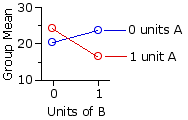
| ||||||||||||||||||||||
| 0 units | 1 unit | rows| A | 0 | units Mg1=20.43 |
Mg2=23.82 |
Mr1=22.13 | 1 | unit Mg3=24.27 | Mg4=16.44 | Mr2=20.36 |
|
| columns | Mc1=22.35 | Mc2=20.13 | MT=21.24 | | ||||||
Preliminary SS Values
B| 0 units | 1 unit | A | 0 | units SSg1=52.45 |
SSg2=67.48 | 1 | unit SSg3=71.02 | SSg4=60.92 |
|
| SST=647.2 | | |||||
| SSwg | = SSg1 + SSg2 + SSg3 + SSg4|
|
| = 52.45 + 67.48 + 71.02 + 60.92 |
|
| = 251.87 | |
| SSbg | = SST — SSwg|
|
| = 647.2 — 251.87 |
|
| = 395.33 | |
| SSrows | = | (∑Xr1)2 Nr1 | + | (∑Xr2)2 Nr2 | — | (∑XT)2 NT
|
|
| = | (442.5)2 | 20 + | (407.1)2 | 20 — | (849.6)2 | 40
|
|
| = | 31.33 | |
| SScols | = | (∑Xc1)2 Nc1 | + | (∑Xc2)2 Nc2 | — | (∑XT)2 NT
|
|
| = | (447.0)2 | 20 + | (402.6)2 | 20 — | (849.6)2 | 40
|
|
| = | 49.28 | |
| SSrxc | = SSbg — SSrows — SScols|
|
| = 395.33 — 31.33 — 49.28 |
|
| = 314.72 | |
The following table shows (in red) the values of [null]Mg* for each of the four groups, as calculated by the method described in connection with Example 1. As before, the observed means of the groups (20.43,23.82, etc.) appear in black. The graphs below the table show the observed group means in comparison with the pattern that would be expected if there were zero interaction between the row and column variables. As you can see from both the table and the graphs, there is a substantial difference between the observed and the expected.
means
B
0 units
1 unit
rows
A
0
units
20.43
23.24
23.82
21.02
Mr1=22.13
1
unit
24.27
21.47
16.44
19.25
Mr2=20.36
columns
Mc1=22.35
Mc2=20.13
MT=21.24
observed 
expected 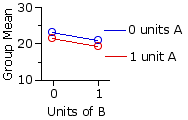
Degrees of Freedom
| degrees of freedom | in general | for the present example Total
| dfT = NT—1
| 40—1=39
| within- | groups (error) dfwg = NT—rc
| 40—(2)(2)=36
| between- | groups dfbg = rc—1
| (2)(2)—1=3
| rows
| dfrows = r—1
| 2—1=1
| columns
| dfcols = c—1
| 2—1=1
| interaction
| dfrxc = (r—1)(c—1)
| (2—1)(2—1)=1
| |
MS Values
| MSrows | = | SSrows dfrows | MScols | = | SScols dfcols | MSrxc | = | SSrxc dfrxc
|
|
| = | 31.33 | 1
|
| = | 49.28 | 1
|
| = | 314.72 | 1
|
|
| = | 31.33 |
|
| = | 49.28 |
|
| = | 314.72 |
|
|
| | ||||||||||||
| MSerror | = | SSwg dfwg
|
|
| = | 251.87 | 36 = 7.0 | |
F-ratios
| Frows | = | MSrows MSerror | Fcols | = | MScols MSerror | Frxc | = | MSrxc MSerror
|
|
| = | 31.33 | 7.0
|
| = | 49.28 | 7.0
|
| = | 314.72 | 7.0
|
|
| = | 4.48 |
|
| = | 7.04 |
|
| = | 44.94 |
| with df=1,36
| with df=1,36
| with df=1,36 | ||||||||||||
Here again is the sampling distribution of F for df=1,36, along with the corresponding tabular portion of Appendix D. The critical values for the .05 and .01 levels of significance are F=4.11 and F=7.40, respectively.
Figure 16.2. Sampling Distribution of F for df=1,36
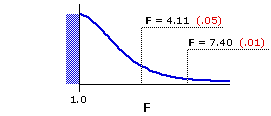
| |||||||||||||||
| df denomi- nator | df numerator| 1 | 2 | 3 | 36 | 4.11 | 7.40 3.26 | 5.25 2.87 | 4.38
| | ||||||
In brief, all three of the effects are significant: the main effects for rows and columns
Once again, the fundamental meaning of the significant row and column effects is that the difference between the two row means
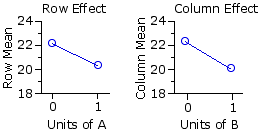
Examine the data in closer detail, however, and you will see that this conclusion is quite the opposite of what is really happening. For group 1, which receives only the inert placebo, the mean level of arousal is 20.43. For group 2, which receives 1 unit of B and none of A, it is higher: 23.82. For group 3, which receives 1 unit of A and none of B, it is also higher: 24.27. The complication comes with group 4, which receives 1 unit each of A and B; for here the effects of the two drugs in combination are not merely additive.
| B | 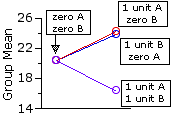
| |||||||
| 0 units | 1 unit| A | 0 | units Mg1=20.43 | Mg2=23.82 | 1 | unit Mg3=24.27 | Mg4=16.44 | |
| Although the above graph captures the texture of the interaction effect in this particular example, the more generic format is the one shown earlier (now adjacent), in which the individual group means are plotted across their respective rows. The fundamental generic meaning of a significant interaction effect is that the difference between | Interaction Effect 
| (i)
| the observed pattern of group means and
|
| (ii)
| the pattern that would be expected if the combined effects of the row and column variables were merely additive
| reflects something more than mere random variability.
| | ||||
ANOVA Summary Table
| Source | SS | df | MS | F | P| between groups | 395.19 | 3 | rows | 31.33 | 1 | 31.33 | 4.48 | <.05 | columns | 49.28 | 1 | 49.28 | 7.04 | <.05 | interaction | 314.72 | 1 | 314.72 | 44.96 | <.01 | within groups | (error) 251.87 | 36 | 7.0 | TOTAL | 647.2 | 39 | |
End of Chapter 16, Part 3.
Return to Top of Chapter 16, Part 3
Go to Chapter 16, Part 4
| Home | Click this link only if the present page does not appear in a frameset headed by the logo Concepts and Applications of Inferential Statistics |